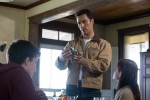In “Interstellar,” Christopher Nolan once again refracts time to create focus on the theme of love.
In Nolan’s 2010 critically acclaimed “Inception,” characters live hours to entire lifetimes in dream worlds. To reverse the time lost, they need only wake up. However, in Nolan’s upcoming science-fiction adventure film “Interstellar,” time passed cannot be reversed.
“Interstellar” has an ambitious setup and gratifying scope, featuring an all-star cast and experienced crew, including frequent Nolan collaborator, composer Hans Zimmer. Though its astronomical scale and complex story line meets a high cinematic standard, the equally important emotional component of the film never fully takes off.
Beginning on a futuristic, crop-depleted Earth, “Interstellar” follows a group of explorers on a lengthy intergalactic mission to find a new home for the human race.
Matthew McConaughey plays Cooper, a farmer and former engineer who abruptly leaves his family to pilot a high-risk expedition with an unknown return date. The remaining crew consists of astronauts played by Anne Hathaway, David Gyasi and Wes Bentley and an advanced, wisecracking robot TARS (Bill Irwin).
After traversing a wormhole and making a stop on a planet where time passes at a slower rate, Cooper learns that his daughter, Murph (Jessica Chastain), has surpassed him in age. Though time can be stretched, it cannot be turned back. The astronauts therefore face a dilemma: Whether or not to press on for the sake of the human race, which means most likely never seeing their loved ones again.
Scenes from a dying Earth are depicted in parallel to the crew’s journey. Murph becomes a scientist who aids the astronauts’ mission from the home planet.
Another player in the human struggle against extinction is “them,” intelligent extraterrestrial beings that have contacted Earth from beyond the wormhole. Their presence is definite, yet their identity is unknown – they are a godlike presence and a mystery to be solved.
The plot of “Interstellar,” kept purposefully secret by the film’s distributors, is riveting and mind-bending in characteristic Nolan-style.
Initially predicted by many entertainment publications to match “2001: A Space Odyssey” in cinematic accomplishment, “Interstellar” is a science-fiction film capable of widespread appeal.
Though its running time comes close to a fidget-inducing three hours, none of “Interstellar” feels extraneous. The struggle against extinction connects and creates complex relationships between characters on Earth, the astronauts and inhabitants of other planets across space and time.
The film is also an exhilarating ride. Cooper mentions Murphy’s law, which dictates that anything that can go wrong will go wrong, in the beginning of the film, foreshadowing the events that take place in space. No space thriller would be complete without its fair share of oxygen depletion and the psychological deconstruction of its characters.
“Interstellar” takes advantage of its settings to set up beautiful shots of extraterrestrial environments and astronomical phenomena. One shot of enormous scale, in which the spaceship is absorbed into the wormhole, shows the spaceship becoming a literal drop in a galaxy. In comparison to 2013’s “Gravity,” “Interstellar” has more varied cinematography.
Most scenes set in space have a subtle artistic quality, but some, including one in which a spaceship essentially becomes a surfboard, are unnecessarily flashy.
“Interstellar” succeeds in terms of plot and cinematography, but falls short in fleshing out its more emotional components.
As Cooper, McConaughey brings a candid humanness to the space crew, almost making up for the flat emotionlessness of the other astronauts. Hathaway’s character speaks of loneliness, but her execution does not exhibit the gravity of her emotion. It is easier to sympathize with TARS, the robot, than any of the astronauts aside from Cooper.
Taking advantage of the parallel story line, the film also introduces an array of thought-provoking themes, including loneliness, survival and the dichotomy between family and community. The characters often dive into nuggets of contemplative dialogue that spins the film into a socially reflective piece as much as it is an adventure film. As a whole, few are developed enough throughout the film to become more than incohesive distractions.
As the final frontier, space is a source of inspiration and a metaphor for loneliness. In film, it has the capacity to distill human emotions and struggles. “Interstellar” does not take advantage of its setting to its full potential.
“Interstellar” has the right conditions to become a profound reflection on love and humanity, but fails to transcend the threshold of a plot-focused entertainment flick with a grandiose setup.
– Eileen Li
